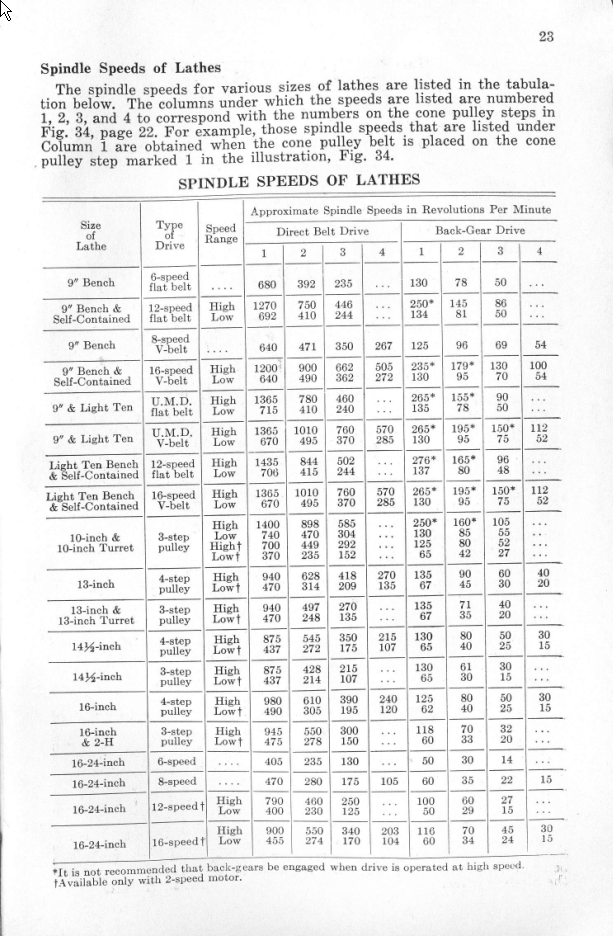SE18
Cast Iron
- Joined
- Feb 13, 2012
- Location
- N. Virginia USA
HTRAL says the countershaft speed should be 255 rpm; however, my pullley size and motor rpm is different than that listed for the 9A, which I have. So I went to the Hercus book: "Textbook of Turning, chapt 10, pg 76, which states: The speed of the driven pulley equals the speed of the driving pulley times the diameter of the driving pulley divided by the diameter of the driving pulley.
First, the speed of the driving pulley should be exactly the speed of my GE motor, 1725 rpm.
I have a 2-pulley setup so each will be different.
First motor pulley:
1725 rpm (speed of driving) X 1.2 (driving diameter) / 10.2 (driven dia) = 203 rpm
2nd motor pulley:
1725 X 2.5 / 9.2 = 469 rpm
Next, I'm gonna calculate using same formula the 3 cones, cone 1 being left and 3 being to the right as you face the lathe.
cone 1 pulley 1: 203rpm of driving pulley x 5 (dia countershaft driving pulley) / 2.5 (dia driven on Headstock) = 406 rpm
cone 1 pulley 2: 469 x 5/.25 = 938 rpm
cone 2 pulley 1: 203 x 4.1/3.3=252
cone 2 pulley 2: 469 x 4.1/3.3=583
cone 3 pulley 1: 203x3.1/4.3=146
cone 3 pulley 2: 469x3.1/4.3=338
So is the math correct?
How would one determine those speeds with backgears engaged. I'm told that pulley 1, the slowest (203 rpm) should be the ONLY pulley used with backgears.
Thanks in advance
Dave V
PS, If the motor says 1725, is that really the RPM or does it slow over the years?
PS2, I suppose the backgears go so slowly I could put a magic marker tick on a cone and with stopwatch count the rpms
PS3, after the math is determine to be correct or not, I can calculate the fpm and then check what metal I'm using (aluminum 1" round) and do my first cut ever!!!!!
First, the speed of the driving pulley should be exactly the speed of my GE motor, 1725 rpm.
I have a 2-pulley setup so each will be different.
First motor pulley:
1725 rpm (speed of driving) X 1.2 (driving diameter) / 10.2 (driven dia) = 203 rpm
2nd motor pulley:
1725 X 2.5 / 9.2 = 469 rpm
Next, I'm gonna calculate using same formula the 3 cones, cone 1 being left and 3 being to the right as you face the lathe.
cone 1 pulley 1: 203rpm of driving pulley x 5 (dia countershaft driving pulley) / 2.5 (dia driven on Headstock) = 406 rpm
cone 1 pulley 2: 469 x 5/.25 = 938 rpm
cone 2 pulley 1: 203 x 4.1/3.3=252
cone 2 pulley 2: 469 x 4.1/3.3=583
cone 3 pulley 1: 203x3.1/4.3=146
cone 3 pulley 2: 469x3.1/4.3=338
So is the math correct?
How would one determine those speeds with backgears engaged. I'm told that pulley 1, the slowest (203 rpm) should be the ONLY pulley used with backgears.
Thanks in advance
Dave V
PS, If the motor says 1725, is that really the RPM or does it slow over the years?
PS2, I suppose the backgears go so slowly I could put a magic marker tick on a cone and with stopwatch count the rpms
PS3, after the math is determine to be correct or not, I can calculate the fpm and then check what metal I'm using (aluminum 1" round) and do my first cut ever!!!!!




 .
.